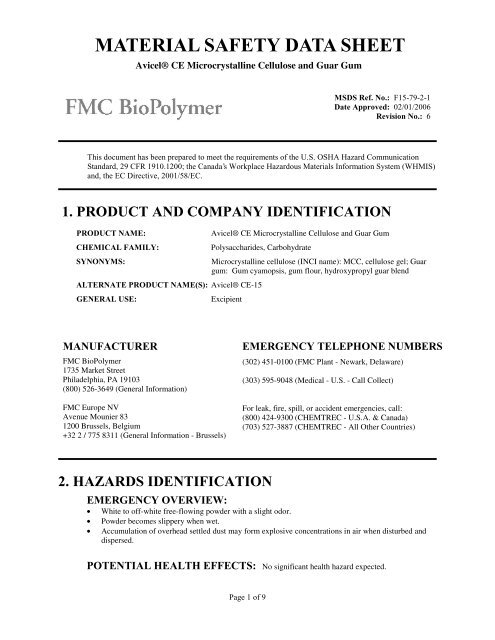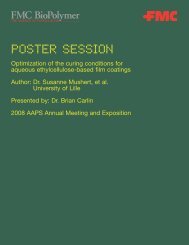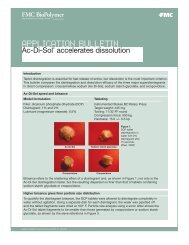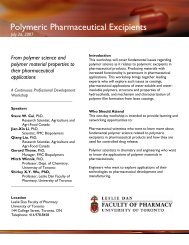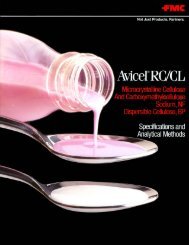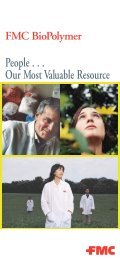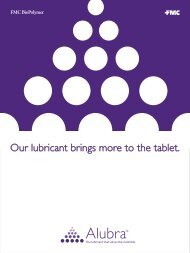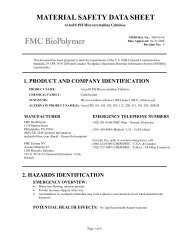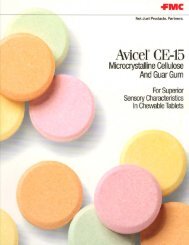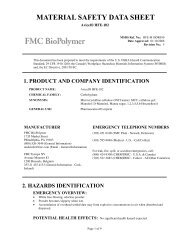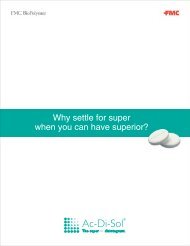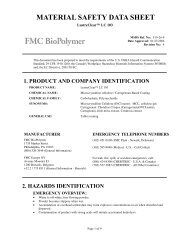Avicel® CE Microcrystalline Cellulose and Guar ... - FMC BioPolymer
Avicel® CE Microcrystalline Cellulose and Guar ... - FMC BioPolymer
Avicel® CE Microcrystalline Cellulose and Guar ... - FMC BioPolymer
- No tags were found...
Create successful ePaper yourself
Turn your PDF publications into a flip-book with our unique Google optimized e-Paper software.
<strong>Avicel®</strong> <strong>CE</strong> <strong>Microcrystalline</strong> <strong>Cellulose</strong> <strong>and</strong> <strong>Guar</strong> Gum (F15-79-2-1) Date: 02/01/20063. COMPOSITION / INFORMATION ON INGREDIENTSChemical Name CAS# Wt.% EC No. EC Class<strong>Microcrystalline</strong> cellulose 9004-34-6 232-674-9 Not classified<strong>Guar</strong> gum 9000-30-0 232-536-8 Not classified4. FIRST AID MEASURESEYES: Flush with water for at least 15 minutes. If irritation occurs <strong>and</strong> persists, obtain medicalattention.SKIN: Wash with plenty of soap <strong>and</strong> water.INGESTION: Drink plenty of water. Never give anything by mouth to an unconscious person. If anydiscomfort persists, obtain medical attention.INHALATION: Remove to fresh air. If breathing difficulty or discomfort occurs <strong>and</strong> persists, obtainmedical attention.NOTES TO MEDICAL DOCTOR: This product has low oral <strong>and</strong> dermal toxicity. It is nonirritatingto the eyes <strong>and</strong> skin, <strong>and</strong> non-sensitizing to the skin. It is expected to have low inhalation toxicity.Treatment is symptomatic <strong>and</strong> supportive.5. FIRE FIGHTING MEASURESEXTINGUISHING MEDIA: WaterFIRE / EXPLOSION HAZARDS: The accumulation of excessive dust on overheadstructures may produce explosive concentrations when disturbed <strong>and</strong> dispersed. According to NFPA 68,(Explosion Venting Guide), the Hazard Class of Dust Deflagrations for microcrystalline cellulose is St-1,the lowest hazard class.FIRE FIGHTING PRO<strong>CE</strong>DURES: For fires involving this material, do not enter anyenclosed or confined fire space without wearing full protective clothing <strong>and</strong> self-contained breathingapparatus (SCBA) approved for firefighting. This is necessary to protect against the hazards of heat,products of combustion <strong>and</strong> oxygen deficiency. Do not breathe smoke, gases or vapors generated.Page 2 of 9
<strong>Avicel®</strong> <strong>CE</strong> <strong>Microcrystalline</strong> <strong>Cellulose</strong> <strong>and</strong> <strong>Guar</strong> Gum (F15-79-2-1) Date: 02/01/2006FLAMMABLE LIMITS: Not applicable6. ACCIDENTAL RELEASE MEASURESRELEASE NOTES: Powder becomes slippery when wet. Maintain good housekeeping practicesto minimize accumulation of settled dust, especially on overhead surfaces. Sweep up the spilled material<strong>and</strong> dispose of in accordance with the waste disposal method outlined in Section 13, "DisposalConsiderations".7. HANDLING AND STORAGEHANDLING AND STORAGE: Use local exhaust or general dilution ventilation to controlexposure to dust. Always use safe lifting techniques when manually moving containers, especially whenshipping containers weighing more than 50 pounds (22.7 kg). To protect quality, store in a tight container ina dry place, at room temperature (approximately 25°C). Pallets should be stacked in a stable manner.Maintain adequate clearance from structural members <strong>and</strong> sprinklers; NFPA <strong>and</strong> U.S. OSHA state aminimum of 18 inches (45.7 cm) clearance shall be maintained between the top of storage <strong>and</strong> the ceilingsprinkler deflectors.8. EXPOSURE CONTROLS / PERSONAL PROTECTIONEXPOSURE LIMITSChemical Name ACGIH OSHA Supplier<strong>Microcrystalline</strong>cellulose10 mg/m 3 (TWA) 15 mg/m 3 (PEL) (totaldust)5 mg/m 3 (PEL)(respirable fraction ofdust)PERSONAL PROTECTIVE EQUIPMENTEYES AND FA<strong>CE</strong>: Whenever airborne dust concentrations are high, appropriateprotective eyewear, such as mono-goggles, should be worn to prevent eye contact.RESPIRATORY: Whenever dust in the worker's breathing zone cannot be controlled withventilation or other engineering means, workers should wear respirators or dust masks approved byNIOSH/MSHA, EU <strong>CE</strong>N or comparable certification organization to protect them against airbornedust.PROTECTIVE CLOTHING: No special clothing is required.GLOVES: No special gloves are required.Page 3 of 9
<strong>Avicel®</strong> <strong>CE</strong> <strong>Microcrystalline</strong> <strong>Cellulose</strong> <strong>and</strong> <strong>Guar</strong> Gum (F15-79-2-1) Date: 02/01/2006COMMENTS:ADDITIONAL EXPOSURE LIMITS:MCC:Australia (TWA) 10 mg/m³Belgium (TWA) 10 mg/m 3 (inhalable dust)China (STEL): 25 mg/m³China (TWA): 10 mg/m³Hong Kong (TWA): 10 mg/m³Irel<strong>and</strong> (TWA): 10 mg/m³ (inhalable dust)Korea (TWA): 10 mg/m³New Zeal<strong>and</strong> (TWA): 10 mg/m³ (respirable dust with no asbestos <strong>and</strong> less than 1% free silica)Singapore (PEL): 10 mg/m³Switzerl<strong>and</strong> (TWA): 3 mg/m³ MAK (respirable)United Kingdom (STEL): 10 mg/m³ (total inhalable dust)United Kingdom (TWA): 10 mg/m³ (total inhalable dust); 4 mg/m³ (respirable dust)9. PHYSICAL AND CHEMICAL PROPERTIESODOR:SlightAPPEARAN<strong>CE</strong>:White to off-white, free-flowing powderAUTOIGNITION TEMPERATURE: Not applicableBOILING POINT:Not applicableCOEFFICIENT OF OIL / WATER: (Octanol/Water) Not availableEVAPORATION RATE:(Butyl acetate = 1) Not applicableFLASH POINT:Not applicableMELTING POINT:Not applicableOXIDIZING PROPERTIES:Not applicablePER<strong>CE</strong>NT VOLATILE:Not availablepH:(In solution) 5.0 - 7.0 (4% solids dispersion)SOLUBILITY IN WATER:(% by weight) Water dispersibleSPECIFIC GRAVITY:(H 2 0 = 1) Bulk density, 0.4 g/ccVAPOR DENSITY:(Air = 1) Not applicableVAPOR PRESSURE:Not applicableCOMMENTS:EXPLOSIVE PROPERTIES: <strong>Microcrystalline</strong> cellulose: St-1MINIMUM IGNITION TEMPERATURE: <strong>Microcrystalline</strong> cellulose: 420°CPage 4 of 9
<strong>Avicel®</strong> <strong>CE</strong> <strong>Microcrystalline</strong> <strong>Cellulose</strong> <strong>and</strong> <strong>Guar</strong> Gum (F15-79-2-1) Date: 02/01/200610. STABILITY AND REACTIVITYCONDITIONS TO AVOID:STABILITY:HAZARDOUS DECOMPOSITION PRODUCTS:None knownStableNone known.11. TOXICOLOGICAL INFORMATIONEYE EFFECTS: Non-irritating (rabbit)SKIN EFFECTS: Non-irritating (PII = 0/8.0) (rabbit)DERMAL LD 50 : > 2,000 mg/kg (rabbit)ORAL LD 50 : > 5,000 mg/kg (rat)INHALATION LC 50 : No data available for the formulation.MCC: > 5.05 mg/l (4 h) (rat) Maximum attainable concentration - zero mortalitySENSITIZATION: (Skin) Non-sensitizing (guinea pig)ACUTE EFFECTS FROM OVEREXPOSURE: This product has low oral <strong>and</strong> dermaltoxicity. It is non-irritating to the eyes <strong>and</strong> skin, <strong>and</strong> non-sensitizing to the skin. It is expected to have lowinhalation toxicity. No significant acute toxicological effects are expected.CHRONIC EFFECTS FROM OVEREXPOSURE: A 90-day feeding study in ratsshowed no adverse effects. No adverse maternal or teratogenic effects were noted when fed to pregnantrats. This product was not genotoxic in a battery of st<strong>and</strong>ard tests.CARCINOGENICITY:NTP:IARC:OSHA:OTHER:Not listedNot listedNot listedNot Listed (ACGIH)Page 5 of 9
<strong>Avicel®</strong> <strong>CE</strong> <strong>Microcrystalline</strong> <strong>Cellulose</strong> <strong>and</strong> <strong>Guar</strong> Gum (F15-79-2-1) Date: 02/01/200612. ECOLOGICAL INFORMATIONENVIRONMENTAL DATA: No data available for the formulation. <strong>Microcrystalline</strong>cellulose is inherently biodegradable in soil. It biodegrades in soil at a rate comparable to corn starch.ECOTOXICOLOGICAL INFORMATION: No data available for the formulation.MCC:48-hour LC 50 > 100%, saturated solution, NOEC = 100% (daphnia)96-hour LC 50 > 100%, saturated solution, NOEC =100% (rainbow trout)96-hour EC 50 > 100%, saturated solution, NOEC = 12.5% (algae)13. DISPOSAL CONSIDERATIONSDISPOSAL METHOD: No special disposal methods are suggested. It is the user's responsibilityto comply with all applicable local, state, <strong>and</strong> federal laws, rules, regulations <strong>and</strong> st<strong>and</strong>ards.14. TRANSPORT INFORMATIONU.S. DEPARTMENT OF TRANSPORTATION (DOT)MARINE POLLUTANT:ADDITIONAL INFORMATION:NoneNot listed in Title 49 of the U.S. Code ofFederal Regulations as a hazardousmaterial.ADDITIONAL INFORMATION:National Motor Freight Classification Item71390, Flour <strong>Cellulose</strong>, EdibleINTERNATIONAL MARITIME DANGEROUS GOODS (IMDG)ADDITIONAL INFORMATION:Not applicableADR - EUROPEAN AGREEMENT CON<strong>CE</strong>RNING THEINTERNATIONAL CARRIAGE OF DANGEROUS GOODS BY ROADPage 6 of 9
<strong>Avicel®</strong> <strong>CE</strong> <strong>Microcrystalline</strong> <strong>Cellulose</strong> <strong>and</strong> <strong>Guar</strong> Gum (F15-79-2-1) Date: 02/01/2006CANADAWHMIS (WORKPLA<strong>CE</strong> HAZARDOUS MATERIALS INFORMATION SYSTEM):Not a controlled product under the Canadian Workplace Hazardous Materials Information System(WHMIS).Domestic Substance List:Listed (components)E NUMBERS:E 460(i) (microcrystalline cellulose)E 412 (guar gum)INTERNATIONAL LISTINGSMCCAustralia (AICS): ListedChina: ListedJapan (ENCS): (8)-568Korea: KE-05339Philippines (PICCS): Listed<strong>Guar</strong> gumAustralia (AICS): ListedChina: ListedJapan (ENCS): (8)-90, (8)-543Korea: KE-18143Philippines (PICCS): Listed16. OTHER INFORMATIONNFPAHealth 0Flammability 1Reactivity 0SpecialNoneNo special requirementsNFPA = National Fire Protection AssociationDegree of Hazard Code:4 = Extreme3 = High2 = Moderate1 = Slight0 = InsignificantPage 8 of 9
<strong>Avicel®</strong> <strong>CE</strong> <strong>Microcrystalline</strong> <strong>Cellulose</strong> <strong>and</strong> <strong>Guar</strong> Gum (F15-79-2-1) Date: 02/01/2006REVISION SUMMARY:This MSDS replaces Revision #5, dated May 20, 2004.Changes in information are as follows:Section 1 (Product <strong>and</strong> Company Identification)Section 15 (Regulatory Information)Section 16 (Other Information)Avicel <strong>and</strong> <strong>FMC</strong> <strong>BioPolymer</strong> Logo - <strong>FMC</strong> Trademarks© 2006 <strong>FMC</strong> Corporation. All Rights Reserved.Page 9 of 9


